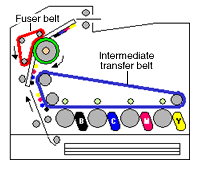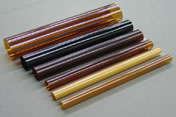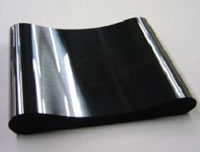Polyimide is a condensation polymer with outstanding heat resistance properties that is made of dianhydride and diamine. Because of these properties, it is utilized in a range of applications in high-temperature environments.
Nitto Denko originally developed polyimide technology for the manufacture of electric insulating material, but in the mid-1980s, one member of the development team employed to devise applications, taking inspiration from a customer comment, hit on the idea of making polyimide film in a cylindrical shape. Products made from polyimide in film form and in molded form were already in existence, but a film in a cylindrical shape with no joints – seamless - had not been developed anywhere.
The usual method of manufacturing a seamless cylindrical film is by extrusion molding, but this is not possible with polyimide because of its physical properties. The development team therefore came up with the idea of using internal molding. This method involves coating the interior of a cylindrical mold with polyamide acid varnish, heating the mold to produce imidization, and then peeling the film away from the mold to create a seamless film (polyimide seamless belt).
But one part of this groundbreaking technique - applying a uniform coating of the polyamide acid varnish to the interior of the mold - proved difficult. After trying a series of solutions, the team developed their own special machine tool for finishing the interior of the mold. This allowed them to successfully deliver the world’s first polyimide seamless belt free of joints and of uniform thickness.
Polyimide polymerization experiment |
The first application of the seamless film was as a precision-operation belt of the kind used in public telephones and other card-operated telephones.Fitted at the insertion point of the card, the belt was recognized as offering high performance. However, the relevant market was small and to succeed in business terms, the product use needed to be extended to different applications.
The marketing team therefore set about developing new applications and came up with the idea of using the product to replace roller mechanisms, choosing as the specific target the rolls of copiers and printers, a familiar and everyday application. In particular, the strongly heat-resistant polyimide seamless belt had potential as a replacement for the fuser roll which fixes the toner to the paper by thermocompression.
After bringing samples of our polyimide seamless belt to copier manufacturers far and wide, one major manufacturer of office equipment indicated an interest. In the copiers of the time, the toner fuser roll had to be heated up, and it therefore took some time after switching on the power before copies could be made. Moreover, power had to be supplied constantly. By replacing the roll with a polyimide seamless belt, the waiting time could be shortened and an energy-saving effect could also be achieved. And so, in 1988, joint development began.
In order to adapt it to the role of fuser belt, the exterior surface of the polyimide seamless belt had to be spray-coated with a layer of electroconductive fluoroplastic. However, fluoroplastic does not adhere well to polyimide. After a series of experiments, the problem was resolved by using a coating of a special primer. In designing the mass-production process, the development team worked closely with system engineers, each side contributing from its store of knowledge to resolve issues one by one.
In 1989, a polyimide seamless belt with an electroconductive fluoroplastic layer was finally perfected, allowing the introduction of a copier that not only eliminated waiting time but also had energy-saving features.
Outline diagram of color printer interior |
Around 1998, Nitto Denko was approached by another major office equipment manufacturer saying that it wanted to follow up the application of the polyimide seamless belt as a fuser belt by adapting it for use as an intermediate transfer belt. The intermediate transfer belt is a belt used in copiers, laser beam printers, and similar machines to transfer toner from the latent image on the photosensitive drum to the paper. It is far greater in diameter than the fuser belt and also needs to be semiconductive. The electroconductivity required is of the level of 1.0E10-12Ω/□, the range most difficult to produce.
The development researcher who had spoken with the manufacturer pointed this difficulty out to the rest of the team and announced that he was thinking of turning the development request down. But the system development team said they wanted to give it a go. Another project was under way and the development of an intermediate transfer belt began.
To develop a polyimide seamless belt with semiconductive characteristics, the first step was to disperse carbon black through the polyamide acid varnish. However, because the polyamide acid varnish is highly viscous, it was difficult to achieve uniform dispersion, making it impossible to achieve stable semiconductivity. In response, the development staff tried a succession of dispersion methods in a process of trial and error before discovering a solution. The solution lay in a method which they had been told by most people was not practicable, but this technique gave them the lead to the final solution and allowed them to achieve stable semiconductive characteristics.
The semiconductive polyimide seamless belt that Nitto Denko developed has been adopted as the intermediate transfer belt of copiers and laser beam printers. The polyimide seamless belt has been acclaimed for its high durability and reliability and also for the easy controllability which comes from being free of joints, and the range of machines it is used in has increased. In February 2002, it received an Excellence Award in the 2001 Nikkei Superior Products and Services Awards Nikkei Business Daily Awards for Superiority.
In the process of product development, there are many cases in which the trial production goes smoothly, but failure occurs at the mass-production stage and the project falls through. This danger surfaced many times with the polyimide seamless belt too. But the development team persevered, thinking that there had to be an answer somewhere and that if they simply kept searching hard enough, a light would come shining through.
Thanks to that perseverance, the polyimide seamless belt has already celebrated more than twenty years of service and continues to evolve. |
Intermediate transfer belt |



